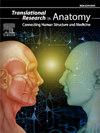桡侧腕屈肌:系统回顾与尸体个案分析
Q3 Medicine
引用次数: 0
摘要
背景:桡侧腕屈肌短肌(FCRB)等变型肌肉在骨科实践和手部功能中具有重要意义。然而,临床文献中缺乏对FCRB的全面生物力学分析和系统综述。本研究的目的是对FCRB进行生物力学分析,并在系统综述的背景下讨论其临床意义。方法在人体常规解剖过程中发现FCRB。采集肌肉的大体参数,并拍照。收集组织样本并进行组织学分析。通过数字光学显微镜测量死后固定肌节的平均长度,以计算归一化最大等距力(Fmax)。采用PRISMA 2020框架对文献进行系统综述。结果2.81 g单侧右侧FCRB呈单倍体形态。它起源于桡骨前外侧远端三分之一处并插入到斜方肌结节处。FCRB呈现半收缩状态。FCRB束长度归一化的Fmax为13.38 n,对43篇相关文章的系统评价表明,FCRB的平均患病率为3.12%。结论FCRB肌肉的生物力学分析、FCRB文献的系统回顾和FCRB综合发病率的荟萃分析为文献增加了新的重要信息,为讨论FCRB病例提供了更好的背景。本研究结果可供骨科医师、放射科医师、物理及职业治疗师、临床解剖学家及医学教育者参考。本文章由计算机程序翻译,如有差异,请以英文原文为准。
Flexor carpi radialis brevis: A systematic review with cadaveric case analysis
Background
Variant muscles such as the flexor carpi radialis brevis (FCRB) can have significant implications in orthopedic practice and hand function. However, a thorough biomechanical analysis and systematic review of FCRB are missing from the clinical literature. The purpose of this study is to conduct a biomechanical analysis of a FCRB and discuss its clinical implications in the context of a systematic review.
Methods
A FCRB was discovered during routine dissection of a human cadaver. Gross parameters of the muscle were collected, and the muscle was photographed. A tissue sample was collected and processed for histological analysis. Mean postmortem fixed sarcomere lengths were measured via digital light microscopy to calculate a normalized maximal isometric force (Fmax). The PRISMA 2020 framework was employed in conducting a systematic review of the literature.
Results
The 2.81 g unilateral right FCRB was unipennate in form. It originated along the anterolateral distal third of the radius and inserted onto the tubercle of the trapezium. The FCRB presented in a semi-contracted state. Normalization of the FCRB fascicle lengths yielded a Fmax of 13.38 N. Systematic review of 43 relevant articles suggests a mean FCRB prevalence of 3.12%.
Conclusions
A biomechanical analysis of a FCRB muscle, systematic review of FCRB articles, and a meta-analysis of FCRB pooled prevalence adds new and important information to the literature, providing improved context for discussing FCRB cases. Results from this study may serve as a useful reference for orthopedic physicians, radiologists, physical and occupational therapists, clinical anatomists, and medical educators.
求助全文
通过发布文献求助,成功后即可免费获取论文全文。
去求助
来源期刊

Translational Research in Anatomy
Medicine-Anatomy
CiteScore
2.90
自引率
0.00%
发文量
71
审稿时长
25 days
期刊介绍:
Translational Research in Anatomy is an international peer-reviewed and open access journal that publishes high-quality original papers. Focusing on translational research, the journal aims to disseminate the knowledge that is gained in the basic science of anatomy and to apply it to the diagnosis and treatment of human pathology in order to improve individual patient well-being. Topics published in Translational Research in Anatomy include anatomy in all of its aspects, especially those that have application to other scientific disciplines including the health sciences: • gross anatomy • neuroanatomy • histology • immunohistochemistry • comparative anatomy • embryology • molecular biology • microscopic anatomy • forensics • imaging/radiology • medical education Priority will be given to studies that clearly articulate their relevance to the broader aspects of anatomy and how they can impact patient care.Strengthening the ties between morphological research and medicine will foster collaboration between anatomists and physicians. Therefore, Translational Research in Anatomy will serve as a platform for communication and understanding between the disciplines of anatomy and medicine and will aid in the dissemination of anatomical research. The journal accepts the following article types: 1. Review articles 2. Original research papers 3. New state-of-the-art methods of research in the field of anatomy including imaging, dissection methods, medical devices and quantitation 4. Education papers (teaching technologies/methods in medical education in anatomy) 5. Commentaries 6. Letters to the Editor 7. Selected conference papers 8. Case Reports
 求助内容:
求助内容: 应助结果提醒方式:
应助结果提醒方式:


